-
Happy Groundhog Day! This Yellow-bellied Marmot is one I photographed up the “Old Fall River Road” in Rocky Mountain National Park. Marmots are also known as groundhogs and woodchucks. Different species of Marmots are found across North America, eastern Europe, Siberia and some of the alpine regions in western Europe.
In the movie “Groundhog Day”, Bill Murray’s character “Phil Connors” was right when he called them squirrels: “This is one time where television really fails to capture the true excitement of a large squirrel predicting the weather.” He was correct because they are indeed members of the Squirrel family.
The Native Americans (Lenni-Lenape People or Delaware Indians, who had been pushed west) near Punxsutawney, PA called them “Wojak” which European settlers pronounced “Woodchuck.” More about this is a moment.
In some countries it was believed that a burrowing animal, a hedgehog (family Erinaceidae) would come out on Bridget’s Day (Bridget, the Celtic goddess of fire) to judge the quality of the weather. It came at the midpoint between the Winter Solstice and the Spring Equinox (on or about February 2nd). In order to sway pagans towards the Catholic Church, Bridget was sainted and Candlemas became a time when the candles that were used throughout the year were blessed by the church.
The Candlemas lyric:
If Candlemas day be sunny and bright, Winter again will show its might.
If Candlemas day be cloudy and gray, Winter soon will pass away.
Now Wojak. When German settlers arrived in what is now Punxsutawney, PA in the 1700s, they brought a tradition known as “Candlemas Day”. There were no hedgehogs in what is now Punxsutawney, PA or anywhere is North America, so they had to utilize a “woodchuck” (“Wojak”) rather than a hedge hog.
And Groundhog Day was born in Punxsutawney, PA.
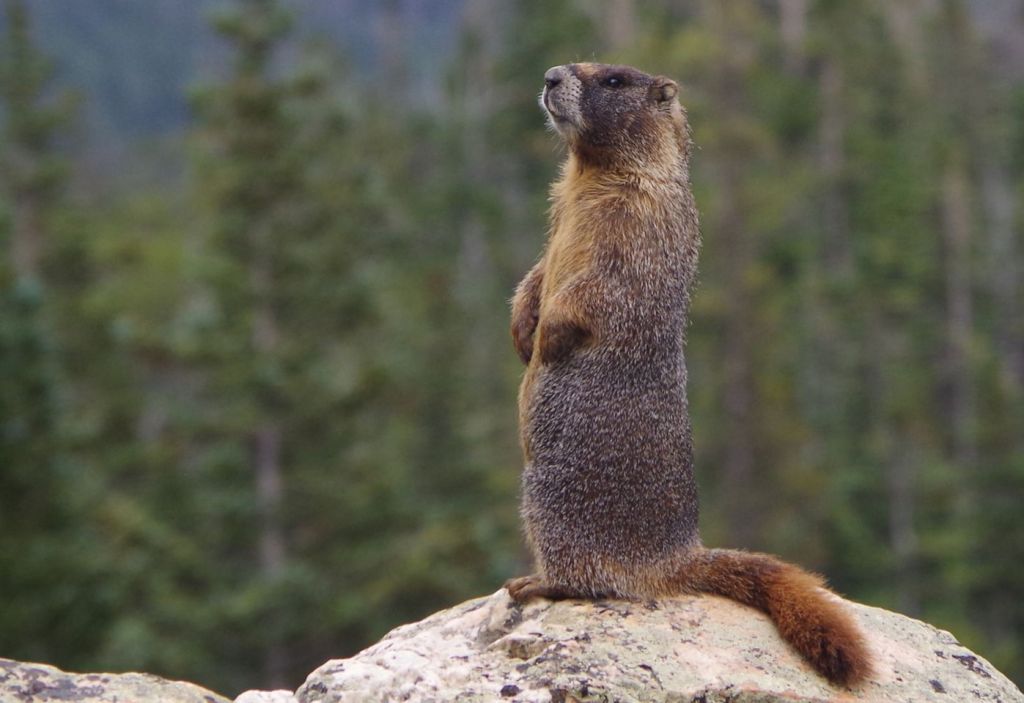
-
Lake Effect Snow and Mesovortices On Lake Michigan
Lake Effect Snow took a rare form last week. Canadian Whirlwinds or mesovortices formed over Lake Michigan Jan 19 2024 as it “cooled” or gave up some of its stored heat because just the right ingredients of weather converged. Cold air from more than one direction blowing over relatively warm water (warm relative to the arctic air) created the series of whirlwinds which can be seen on the satellite and radar images. The vortices create incredible snow amounts over short periods where they form. The odd snow squalls were caused by ‘converging winds which were also angled, behaving like two hands rubbing a rope of dough. According to a published article in the Bulletin of the American Meteorological Society Vol 132 (9) 2004, winds within the wind-parallel band region might be about 10 mph near the surface increasing to around 20 mph at one mile altitude. Mesovortices which are Lake Effect produce “locally” heavy snows. Michigan City got three feet of snow while nearby South Bend received only 6 inches.
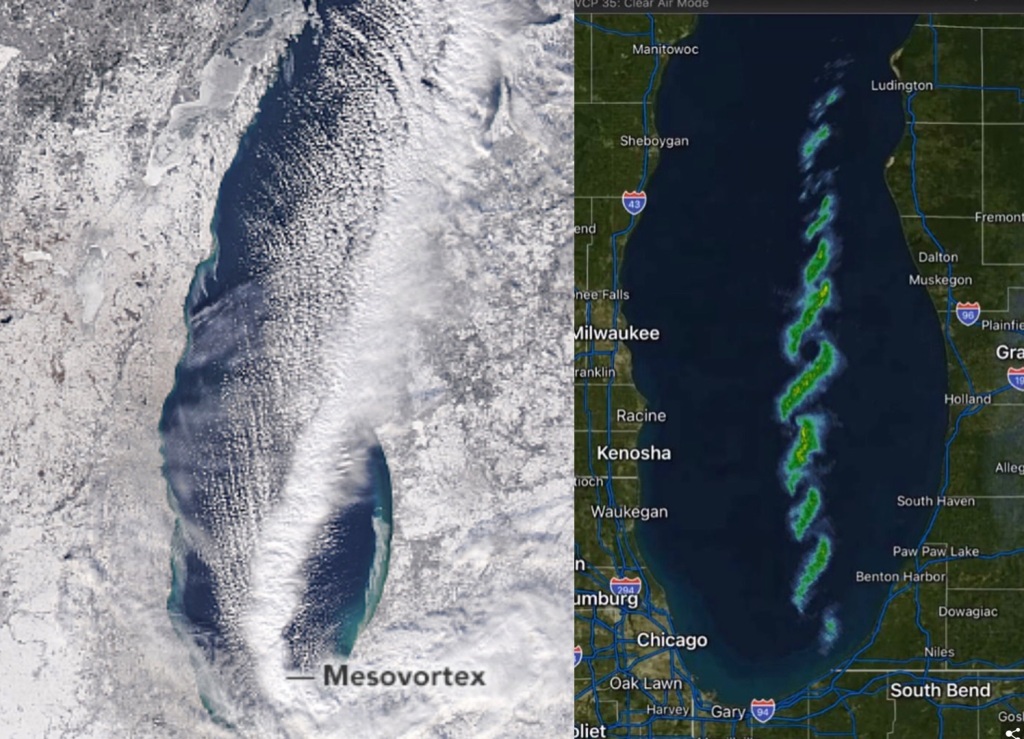
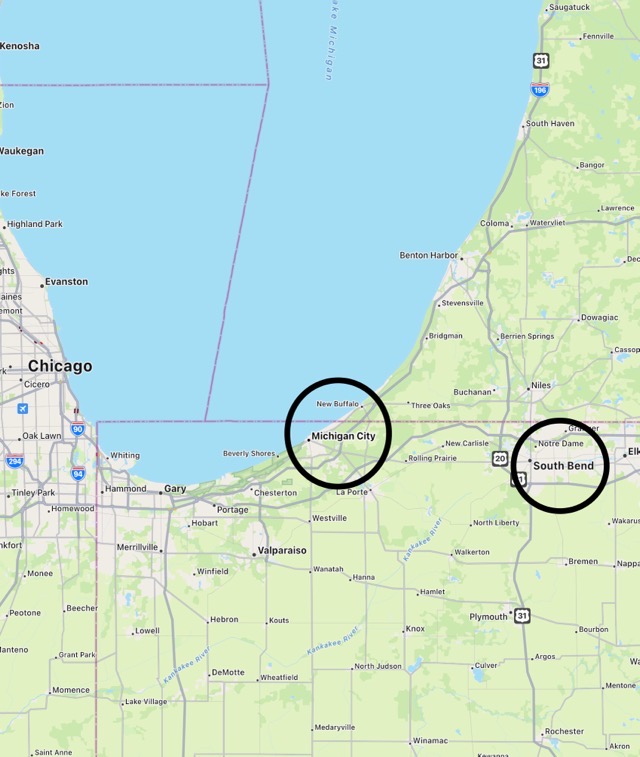
-
Lake Erie will probably experience a rare strong “Seiche” this weekend (Jan 13 2024). Fetch is a measurement of distance that wind can travel across water more-or-less uninterrupted. If the fetch is long, the effects are greater. Sustained winds traveling southwest to northeast produce a long fetch across Lake Erie.
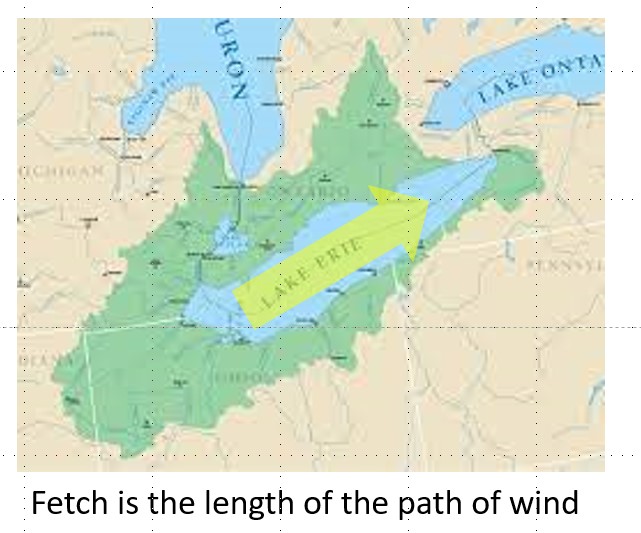
The sustained winds cause water to build-up at the downwind side of the fetch.
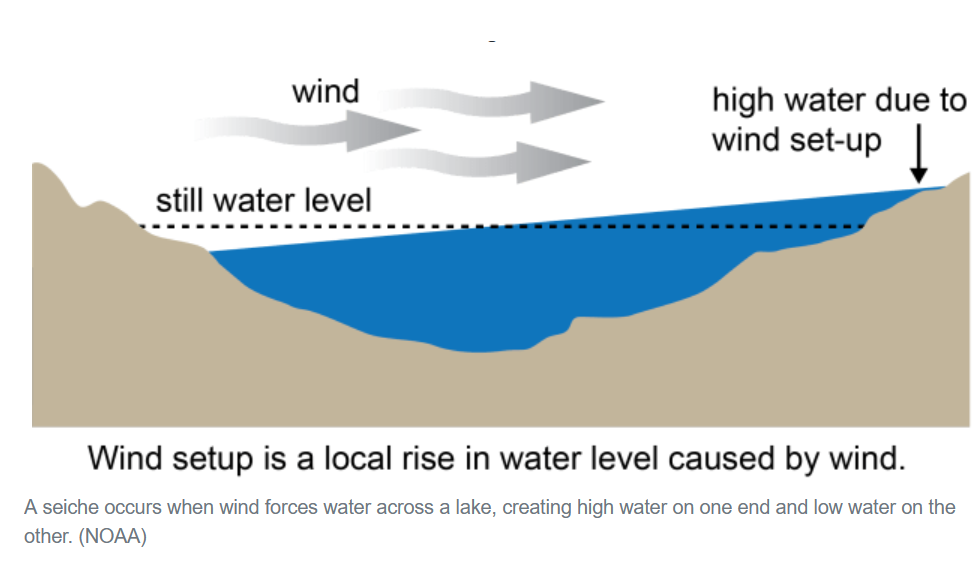
Look at the weather pressure isobars and the deep low pressure over Lake Erie for Jan 13 2024.
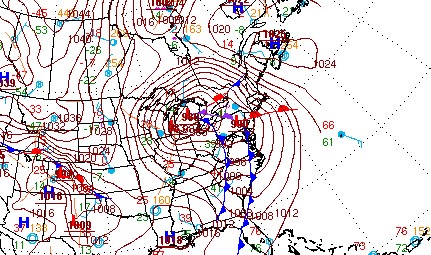
Here is the predicted water level changes for Jan 13 2024, with water Level decreasing at Lake Erie’s west end (Toledo) and rising at Lake Erie’s east end.
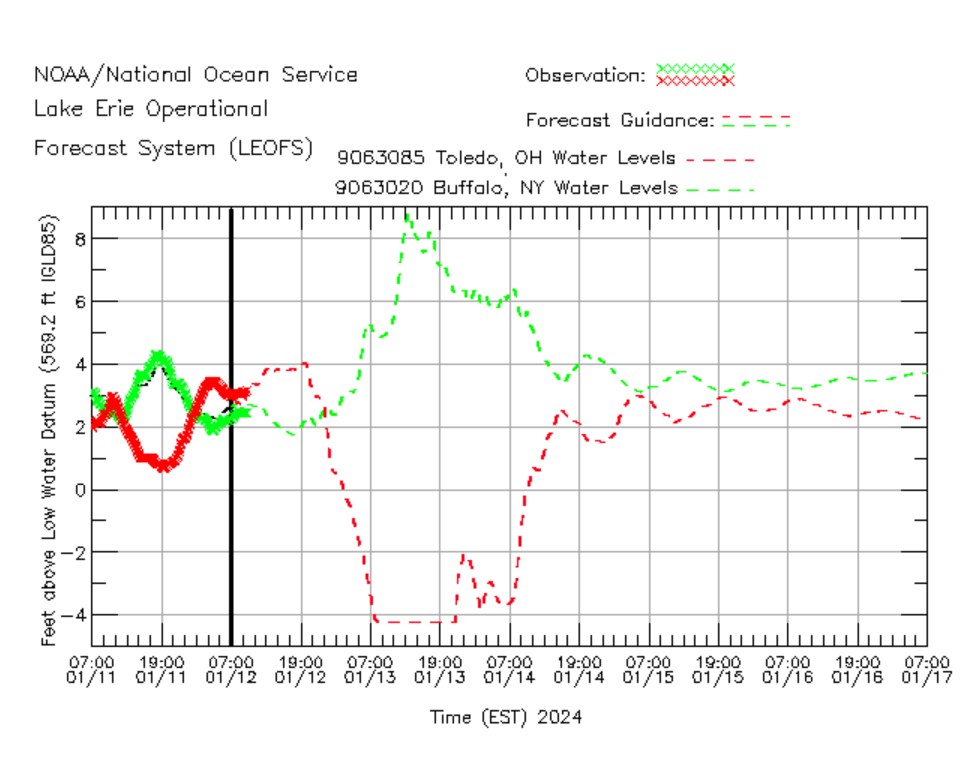
In 1844, a 22-foot seiche breached a 14-foot-high sea wall killing 78 people and damming the ice to the extent that Niagara Falls temporarily stopped flowing
-
OLLI Class 1 Summary
Water exists in three states on planet earth: solid, liquid and gas. What allows this is water’s “hydrogen bonds” which are very short-lived attractions between adjacent water molecules. Water is a polar covalent bonded molecule. The Oxygen does not share electrons with the two hydrogens equally, resulting in the oxygen side of the molecule being negative and the two hydrogen sides being positive. So the positive hydrogen sides are attracted briefly to the negative oxygen side of another nearby water molecule. They just keep changing unless the temperature at sea level drops to 0 Celsius in which case the water molecules organize into a highly structured and low-density solid form, ice. Few molecules exist in all three states (solid, liquid and gaseous) at “common” temperatures and pressures of earth’s ecosystems. There was a discussion of methane hydrate (methane’s solid form deep under the ocean’s bottom.
Water’s high heat capacity is due to its hydrogen bonds. Water heats slowly and it also cools slowly. This stability makes it an ideal molecule to comprise 70% of animal tissues. The high heat capacity is why we observe “Lake Effect Snow” in January when cold Arctic air blows over warmer waters of large bodies of water which have not yet reached their coldest temperatures of the year.
Water’s cohesion property means water like to stick to other water molecules. Water’s adhesive properties means that water likes to adhere to other materials. These two properties are a result of its hydrogen bonds. It is these two properties that allow trees to pull water (and dissolved nutrients) from the ground all the way to the highest leaves as the leaves transpire through their stomata (pores on underside of leaves).
Hydrogen bonds hold the two strands of DNA in every one of your chromosomes together until the time that the chromosomes need to duplicated. Since life on this planet evolved in a watery medium DNA has acquired a double stranded, tilted, helical structure to protect the DNA from water and water-dissolved chemicals which can damage the DNA.
We covered photosynthesis’s “light reaction” where pigments in the chloroplast’s internal membranes capture a photon of light, transfer the photon’s energy from one pigment to another. A water molecule is split into H+, an electron and Oxygen. The electron lost from water is used to replace an electron lost from an excited photo-pigment. In the end two energy rich molecules are synthesized by plant during the light reaction: NADPH and ATP. These two energy rich molecules are used to assemble glucose in photosynthesis’s “dark-reaction” where the plants take up CO2. In the end, plants lower CO2, add Oxygen to the environment and build plant tissue from glucose and minerals they uptake with their water. No water, no photosynthesis!
-
The Water Cycle (Graphic Made By USGS)
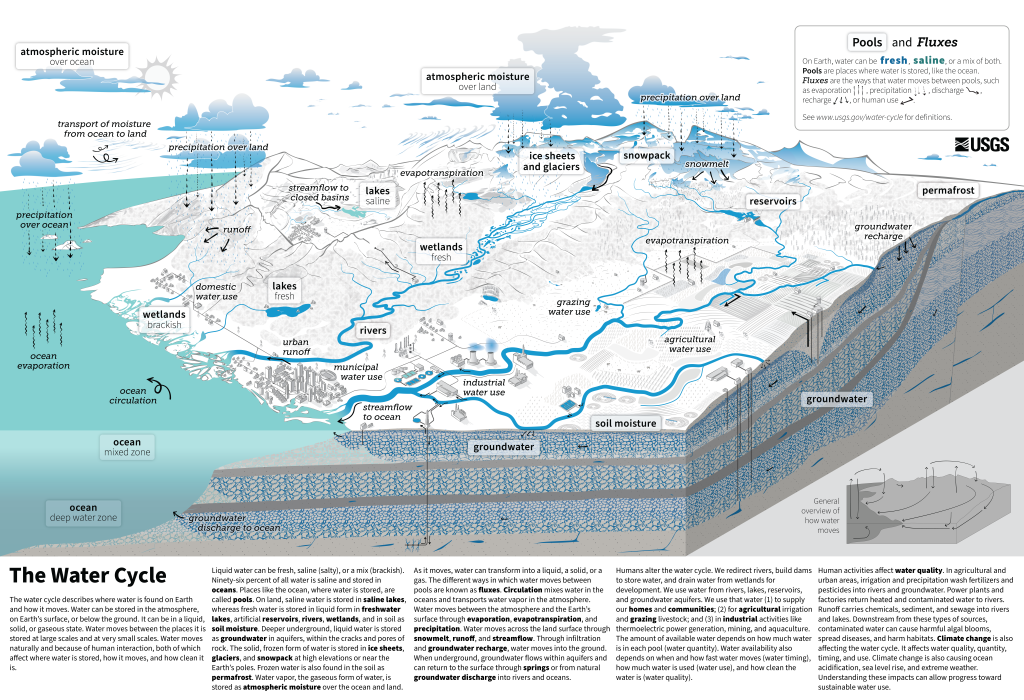
-
Lake Effect Snow
Why do North America’s “Lake Effect Snows” seem most severe in December and January? “Lake Effect Snowstorms” occur mostly around the Great Lakes in the United States during the months of December and January. The meteorological ingredients needed are cold air blowing across a large volume of “relatively” warm water. Lakes Superior, Michigan, Huron, Erie and Ontario might not seem “relatively” warm In December but they are in terms of their annual cycle of water temperature in relation to the air temperatures. Water by the very nature of its physical properties has a very high “Heat Capacity.” This means water warms slowly and cools slowly. Water temperatures are still cooling downs in North America’s lakes and reservoirs in December. Cold north winds pick up moisture which evaporates off the lake (left side of illustrations), cools into snow flakes and falls downwind of the lake. Eventually the lake will cool substantially as the winter progresses. If ice cover forms (right side of diagrams) the capacity to produce “lake effect” snow is reduced and then eliminated as ice cover grows. The deeper the lake the more thermal mass is stored in the lake. The thermal mass of water which is warmer than air and the dictates the magnitude and duration of the “lake effect snow” season. Individual “lake effect” events are influenced by the “fetch” or distance that the cold air blows across the water. Deep lakes like Superior (> 1000 feet), Huron and Ontario (depicted in the upper portion of illustration) have more capacity to produce lake effect snow than Lake Erie. Lake Erie’s deeper eastern basin and Lake Ontario combine to produce lots of lake effect snow for the state of New York, especially if the prevailing cold winds are blowing west to east and thus increasing the “fetch.” Since winter’s cold air tends to blow from the North and West, lake effect snows are more common along Lake Superior’s southern shore, and Lake Michigan’s eastern shore. The same applies to Lakes Huron, Erie and Ontario. Theoretically, the warmer the Great Lakes become over the course of late spring and summer, then the longer they will provide warm moist air as they cool in the late Fall and early Winter, and hence more Lake Effect Snow. There are “ocean-effect” and “bay-effect” snow storms too. The west coast of northern Japan experiences serious sea-effect snow from cold air crossing the Sea of Japan. The Black Sea, Caspian Sea, Baltic Sea and North Sea also produce ocean-effect snow events.
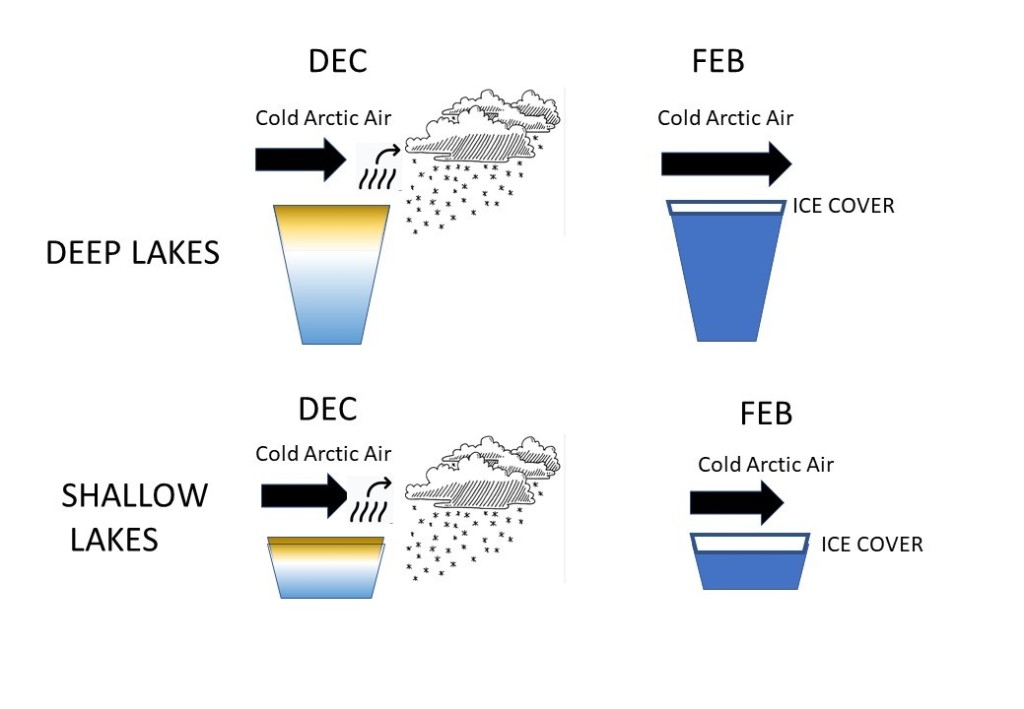
-
Species and Speciation Part 3 – Dingos and Painted Dogs of Africa
All that is left out so far in this discussion are Dingos of Australia and Africa’s Wild Dogs (or Painted Dogs). All the DNA evidence suggests Dingos are descendants of domestic dogs which the first persons (probably Indonesians) to colonize Australia brought with them. It is believed that Dingos have been in Australia for 5,000 to 10,000 years, perhaps longer. For tens of thousands of years everywhere humans went as they spread across the globe they brought with them dogs. Australia and North American were the last continents to be colonized by man. The African Painted Dogs (Lycaon pictus) are another matter. Painted dogs have been in Africa a long time. The oldest L. pictus fossil dates back to 200,000 years ago and was found in a cave in Israel. First off, Painted Dogs are not feral dogs, wild domesticated dogs or village dogs. They are just “wild” and do not spend time at the edges of human settlements. There really is little genetic research on them. They are highly endangered and number only perhaps 6000). It also appears that they do not breed with feral or village dogs in Africa. Their social structure is very strong. It is believed that there is a strong behavior for males to not breed in their colony. However, their populations are so fragmented that males seeking other mates fail to do so. This is believed to be a contributing factor to their decline.
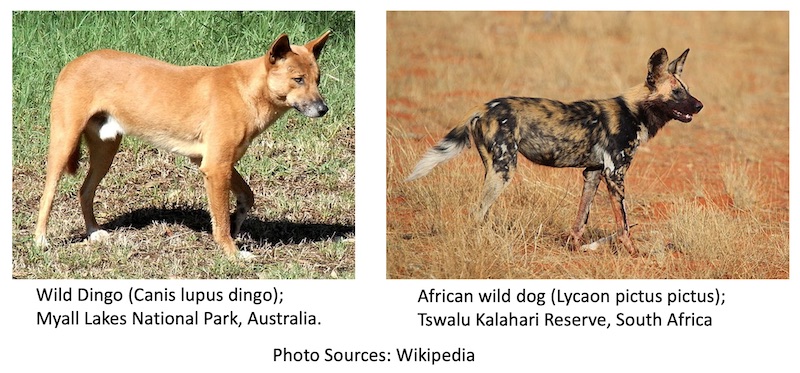
Australian Dingo (Left) and African Painted Dog (Right) -
Species, Speciation, Coyotes and Wolves. Part 2 of 2.
Now back to Coyotes and Wolves. Evolutionary biologists measure statistical differences between closely related populations with the “Fixation Index” (FST). It is a measure of population differentiation due to genetic structure. FST values range from 0.0 to 1.0. Modern genomic sequencing of DNA allows very precise examination of DNA differences between organisms. FST also includes a measure of “variation” so FST values can be compared statistically. When FST is larger than 0.35 populations are normally characterized as different species.
The three extant genus Canis species in North America are all genetically very similar. For example, based on whole-genome sequence data, the pairwise FST value between gray wolves and coyotes is 0.153, between gray wolves and red wolves is 0.177, and between coyotes and red wolves is 0.108 (vonHoldt et al., 2016). All well below the 0.35 threshold!
About Red Wolves. Red wolves once ranged from Texas to Pennsylvania (centered in the southeastern U.S.) but today are found only in eastern North Carolina. Most are captive bred with less than two dozen in the wild. While there are those who would like to consider the red wolf a distinct species (e.g., Canis rufus) all the molecular evidence points to the fact that Coyote genes have intermixed with gray wolf genes. It is believed that this probably happened as wolves were exterminated in the east and Wolf numbers were low forcing some wolves to mate with coyotes. Even if Red Wolves are really just a sub-species of Gray Wolf they still can be protected under the Endangered Species Act.
The authority on naming mammals is “Mammal Species Of The World” 2005. An on-line version is hosted by Bucknell University.
The red Wolf is listed as a sub-species of Canis lupus (as is the Mexican wolf which also has coyote genes “admixed”). On the other hand, a study was commissioned in 2018 by the U.S. Fish and Wildlife Service to develop an independent assessment of the status of the Red Wolf. That study suggested the Red Wolf deserves to be named its own species.
So as far as coyotes and wolves are concerned the DNA evidence clearly shows that while they might be classified as two distinct species they really are one species headed toward two species. Behaviorally speaking they seem quite different, perhaps worthy of distinct species names. They are stars in a motion picture measured in many more hours than we are used to; measured not in hours, but in millennia.
Addendum: Coyotes are poised to expand their range to a new continent. The North American canine native has now reached the Darién Gap – a dense wilderness on the border of Colombia and Panama, at the very doorstep of South America. If the coyote succeeds, it would be a new chapter in an amazing evolutionary story that’s played out over the past half century. What could block their making their way to South America? Jaguars in the forests and the Panama Canal. I think they will make it.
Next Post: Dingos and African Painted Dogs
-
Species, Speciation, Coyotes and Wolves. Part 1 of 2.
Teaching “Speciation” to Undergraduate Biology majors was always challenging, especially when teaching non-majors. I used the Species Versus Speciation approach. Think of a “Species” as a photograph and “Speciation” (the process by which new species arise) as a motion picture. Since the dawn of classification of living things we have employed the binomial system of nomenclature where a species is given its own Latin “species” name and lumped into a Genus which a species would share with closely related species. Everyone was taught in Introductory Biology that a species cannot produce fertile offspring if it hybridizes with a closely related species (e.g., a donkey and horse produce a mule which are almost always sterile. That is what makes a species? Hold your horses!
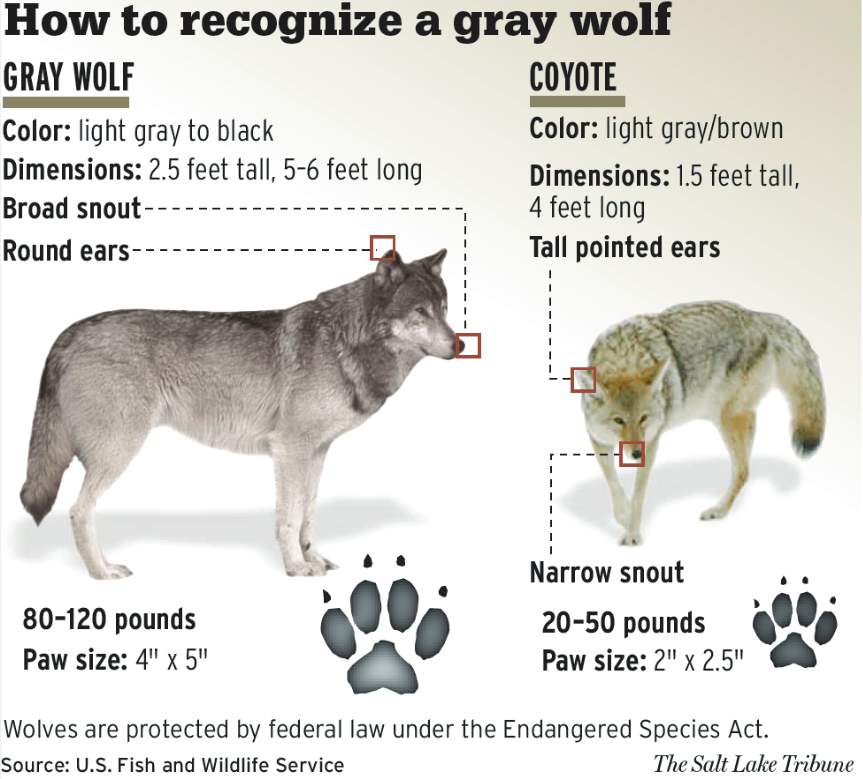
US Fish and Wildlife Service Information Picture. The Coyote (Canis latrans) and the Grey Wolf (Canis lupus) present an interesting example for “Species vs Speciation.” Whereas humans did not reach North America until perhaps 14,000 years ago (give or take a 1,000 years), the ancestors of today’s North American canids (coyotes and wolves) were on the continent for at least eight million years. There is evidence that canids migrated to Eurasia from North American and then came back again.
In more modern times (e.g., before Columbus sailed the Ocean Blue) the wolf was distributed more northerly and the coyote more southwesterly in North America. The two did overlap especially in the southwest U.S. Had we had federal and state wildlife agencies conducting wildlife surveys 400 years ago we might be able to solve some of the debates about canids in North America. We did not and wild canids were seen as threats to human endeavors. As Europeans colonized the eastern U.S. and Canada and made their way west they systematically exterminated wolves. Over the last 100 years coyotes have expanded east and north and are now found from parts of Alaska to Eastern Canada and most of the U.S. (with the exception of Hawaii of course). In fact, coyotes might soon make their way to South America (Part 2).
The physical resemblances and differences between Coyotes and Wolves are apparent (body size, head shape etc.). There are behavioral differences which have acted to isolate them from one another. These are called “pre-zygotic” factors because then tend to prevent sperm and egg from every uniting. Yet these two “species” and domestic dogs (Canis lupus domesticus) are all capable of producing perfectly fertile and healthy offspring. So are coyotes and wolves different species? Yes and No. Motion Picture vs Photo.
This is because coyotes and wolves are a great example of “speciation” where a once common ancestor is diverging into different lineages or new species. It is a “movie” which has not yet produced two very distinct “photos” or species. Speciation takes a long time for mammals and other species which produce only one or two sets of offspring per year, especially when their geographic ranges overlap, allowing occasional mixing of genomes. All the canids have 39 pairs of chromosomes so their Karyotypes match meaning the sperm and eggs unite properly and embryological development proceeds normally after fertilization. The genomes are very close (i.e., all the same genes are there, located on the correct positions on the correct chromosomes).
Speciation is just another term for macro-evolution which culminates in new species after countless small changes (micro-evolution) produce a distinct species. The small changes also include behavioral characteristics which act to produce the pre-zygotic isolation. The biological ingredients of evolution are mutation in DNA, the environment acting on the physical and behavioral changes resulting from phenotypic changes (were the changes beneficial or detrimental) and time, lots of time.
Next Week. Part Two: the genetic evidence.
-
Your Dog’s Floppy Ears… Embryogenesis and Genetics
Several published studies summarized here show how embryology and modern genetics begin to answer the biological basis of selective breeding of modern dogs.
It is well established that Australian Dingos and domesticated dogs are all descended from Wolves. The only questions are how and when. Archeology and cave drawings really can’t answer that question. Modern genetics can provide many more answers. Genetics can answer the how or genetic basis of the origin of traits.
No domestic animal has shared more of its evolutionary history in direct contact with humans than the dog (Canis lupus familiaris, also referred to as Canis familiaris), living alongside humans for more than ten thousand years since domestication from its ancestor the gray wolf (Canis lupus). The location, timing, and number of dog domestication events is still debated
Recently published research on the genetics of “Village Dogs” has answered some of the questions. Village Dogs are free-ranging, free-breeding dogs whose ancestors were indigenous to a geographic area. In effect, they are the descendants of the founding population of dogs in a region. Village dogs roam and scavenge for food near human populations and are able to mate freely. The current population of dogs on earth is estimated at 900 million of which only 20% are pets, the remainder being feral and village dogs.
Most modern breeds arose in the last 300 years and contain only a small portion of the genetic diversity found among the vast majority of extant dogs. Instead, semi-feral village dogs are the most abundant and genetically diverse modern dog populations and have undergone limited targeted selection by humans since initial domestication.
A study of “Village Dogs” from many remote areas across the globe which compared village dogs to wolves and domestic dogs revealed that much of the variation of the current breeds lies in about 240 genes which are expressed during embryonic development in “Neural Crest Cells.”
A fertilized ovum divides hundreds of times and eventually becomes a solid ball of cells. Then it becomes a hollow ball of differentiating cells. Eventually a dorsal neural plate forms and turns into a neural tube. The neural tube forms the early brain and spine. Neural Crest Cells are located just above the neural tube.
Neural crest cells are a type of stem cells that travel along defined routes from their starting location near what will become the spinal cord, to their final destinations.
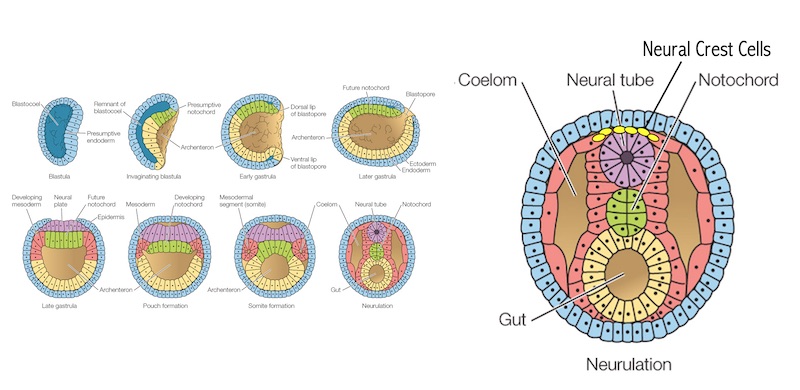
Left Embryogenesis; Right Location of Neural Crest Cells Neural crest cells play a major role in defining the forms and functions of multiple tissues in all animals with backbones including most of the skull, face, cartilaginous tissues (such as dogs’ floppy ears), and even pigmentation of the skin and fur. In addition to changing the outward appearance, these cells ultimately contribute to the development of the brain, nervous system, and adrenal systems, all of which can influence behavior.
Changes in the number or activity of neural crest cells in any of these final body locations can subsequently alter the size, shape, or level of expression of the corresponding trait.
It is interesting that there are human syndromes associated with the same genes in humans. Human syndromes resulting from improper development of neural crest cells include facial deformities and hypersociability. These parallels between dogs and humans are what make understanding dog genetics valuable.
Here is a source link: Pendleton, A. L., Shen, F., Taravella, A. M., Emery, S., Veeramah, K. R., Boyko, A. R., & Kidd, J. M. (2018). Comparison of village dog and wolf genomes highlights the role of the neural crest in dog domestication. BMC Biology, 16(1), 1–21. https://doi.org/10.1186/s12915-018-0535-2
Science and Nature by JW Foltz
Science, Nature and the Environment
“…when the last individual of a race of living things breathes no more,
another heaven and another earth must pass before such a one can be again” C. William Beebe, 1906.
“
